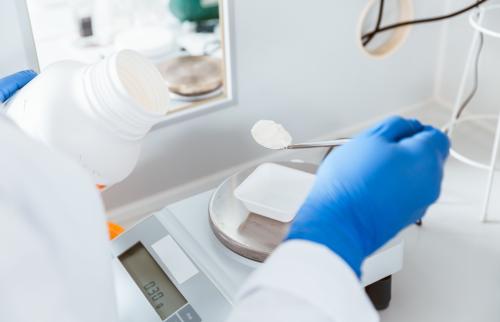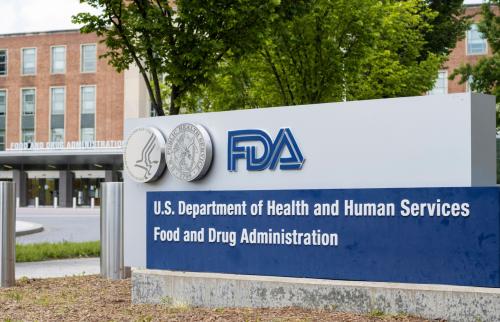Introduction
As the popularity of GLP-1 drugs for weight loss soared, the Food and Drug Administration (FDA) began announcing that FDA-approved versions of various GLP-1 drugs were going into shortage, starting with semaglutide (the active ingredient in Wegovy and Ozempic) in March 2022. This, in turn, created a legal pathway for pharmacy compounding of exact copies of the patent-protected, FDA-approved products. These compounded products are not made in drug manufacturing facilities but are mixed by pharmacies.
With a broad consumer appeal around weight loss, a price much lower than the patent-protected versions, and no restrictions on marketing, compounded GLP-1s have been used by millions of patients, boosting a cottage industry providing direct-to-consumer semaglutide and other related products through telehealth companies and medical spas. These providers partner with compounding pharmacies that then mix the prescribed drug from bulk ingredients.
Then, in February 2025, FDA removed semaglutide from its shortage list, giving some pharmacies, called 503A pharmacies, until April 22, 2025, to stop dispensing exact copies of semaglutide, and others, so-called 503B pharmacies, until May 22, 2025.
But the compounding of semaglutide is unlikely to end. One reason is that 503A pharmacies can continue compounding so long as the product is not “essentially a copy.” Second, although compounding of semaglutide will now be allowed in a narrower set of circumstances, it would be the responsibility of the FDA and the States to enforce compounding laws—a potentially tall order given the recent FDA cuts and limited State capacity for oversight.
The continuation of compounding will likely continue the debate around the safety of compounded products. Much of that debate has centered around the safety of sterile-injectable drug compounding, with the quality of active pharmaceutical ingredient (API) or “bulk” that pharmacies use to compound receiving much less attention. But as I describe in this article, bulk manufacturers of semaglutide have no external reference standard for quality, leaving it up to them to determine product specifications. This is particularly concerning for a complex peptide, of which semaglutide is one.
This article is organized as follows. I first explain the complexity of peptides and lay out the regulatory framework for manufacturing quality in API and bulk products. I then use various FDA datasets to characterize who is marketing and shipping semaglutide to the U.S. I find that the announcement of the shortage led to a significant proliferation of companies, almost exclusively from China, that were marketing semaglutide in the U.S., with little indication that they are doing so in support of generic drug applications. I also review these companies’ FDA inspection history, finding that a large share of them were never inspected by FDA, and many of those that were had drug quality assurance violations.
I conclude with a discussion of policy around bulk manufacturing of semaglutide and other drugs without an established product quality reference standard.
How is semaglutide made and why does it matter?
There are two ways to manufacture semaglutide active ingredient powder: recombinant RNA methods typically used for making biologics or a chemical synthesis process called solid state peptide synthesis. Novo Nordisk, the manufacturer of the FDA-approved commercial product, uses yeast-based recombinant RNA methods to make semaglutide. Likely because of the cost and technological considerations, FDA expected that generic manufacturers would pursue solid state peptide synthesis.
Various problems can occur if peptide production process is not well controlled. For this reason, FDA has published various guidances for generic peptide manufacturers, in addition to guidance on how to establish sameness vis-a-vis the brand they copy. One issue with synthetic peptide methods is that the resulting amino acid chain may end up being different than the intended active ingredient. For example, FDA has raised concerns about the compounding of semaglutide salts that have not been tested for safety or efficacy. Another issue is that the repeated coupling and washing steps may result in final product impurities if not properly conducted. Testing of compounded products has found formaldehyde and various unidentified impurities.
It is important to note that health consequences from such impurities may not show up in FDA’s adverse reporting system. To report an adverse event, patients and providers must make a reasonable inference that a drug may have caused the event. For this reason, some post-marketing actions by FDA have a different origin than adverse events reports. A good example is the significant rethinking around identifying the presence of carcinogenic NDMA in products—an issue that arose solely based on testing products, not adverse events.
How does FDA assure that active ingredients used in drugs are safe and effective?
The regulation and oversight of bulk manufacturing for compounding differs substantially from that of manufacturers supplying API for branded or generic products.
Manufacturers of branded and generic drugs go through an FDA approval process. As part of this process, they must submit information about chemistry, manufacturing, and controls (CMC): How the active ingredient is made, what the manufacturer proposes as specifications for quality, and tests it will use to assure the product meets specifications. There is often back-and-forth between FDA and the applicants about the proper controls, specifications, and tests.
There are two other regulatory constructs relevant to this discussion.
One is the role of U.S. Pharmacopeia (USP) monographs, which lay out expectations around the drug’s identity, strength, and purity, including relevant tests. FDA-approved drugs must, by law, follow USP monographs if they exist. Monographs are developed through an extensive scientific process, usually finalized around the time generics enter the market. If no USP monograph exists—as is in the case of semaglutide—FDA does not require the development of a new monograph for approval, but applicants should work with USP to create a monograph through the USP Pending Monograph Process (USP-PMP).
The other relevant construct is a drug master file (DMF), which is used when a third party makes API. To protect its intellectual property, the API manufacturer files its proprietary CMC information in a DMF. A new drug applicant, whether brand or generic, will reference that DMF in the CMC section of its application. FDA will not review the DMF content until they review the content of the generic drug application. However, FDA will review whether the DMF has appropriate sections if the manufacturer pays the DMF fee required under the Generic Drug User Fee Act (GDUFA).
After the approved drug is on the market, whether generic or branded, API manufacturers must test each batch of the product according to the identified specifications using validated tests and, with each batch, issue a certificate of analysis (COA) that contains specific test results about the substance.
Manufacturers making bulk product face a different set of requirements: They must register with FDA and have a “valid” COA. But in the case of semaglutide, there is no USP monograph and no assessment of the DMF as part of an application, so bulk manufacturers of semaglutide are, in effect, setting their own standards for what constitutes a quality product. This means that a manufacturer can determine that 15% of the batch can be materials other than semaglutide, as noted in one semaglutide bulk COA reviewed by the author. The manufacturer can also determine that testing for heavy metals or residual solvents is not necessary.
Table 1 summarizes the regulatory standards for semaglutide bulk used in compounding versus semaglutide API used in abbreviated new drug applications (ANDAs). I am using ANDAs as a reference because they are copies of the branded semaglutide products, just as compounded products are.
Who is ready to ship semaglutide bulk?
To assess which manufacturers are ready to ship bulk to U.S. buyers, we can leverage an FDA requirement that firms shipping unfinished drug product into the U.S. or across state lines must obtain a National Drug Code (NDC). Any firms producing bulk product must also register with FDA in the so-called electronic Drug Registration & Listing System (eDRLS). Using eDRLS and the unfinished product NDC directory, one can determine who is marketing semaglutide bulk to U.S. buyers, when they began to do that, and where their business is located.
The NDC registration data is not well suited for determining whether the powder semaglutide is intended for use in the development of generic drug versions. But other sources suggest that seven companies submitted semaglutide ANDAs on December 6, 2021—the first day they were allowed—with more after that. If those ANDA applicants are developing generic semaglutide outside the U.S., there would be no need for them to obtain an NDC code. A comparison of legal filings and the list of DMF holders suggests that some Indian manufacturers are indeed developing generic semaglutide in-house.
Figure 1 plots the number of semaglutide manufacturers requesting NDC codes for semaglutide powder, all organized by the date of the first NDC request. Additionally, manufacturers that obtained NDC codes are organized by country. Repackagers with NDC codes are excluded from this analysis. Figure 1 also includes DMF filings, which are not necessary for bulk manufacturing but can be useful for promotional purposes. It also lists the number of DMFs for which the firm paid a GDUFA DMF fee.
The data reveal some expected and unexpected patterns.
As expected, there are not many semaglutide powder manufacturers before the shortage begins and before generics can file their applications with FDA. Initially, there is just Novo Nordisk shipping to its North Carolina facility. In 2018 and 2020, two other companies, one European and one Chinese, obtain NDC codes. Given the timing of their NDC requests and the subsequent filing of drug master files and paid GDUFA fees, it appears that both these companies are working with generic drug developers. During that time frame, several other manufacturers appear to be developing semaglutide in-house—they file DMFs and pay GDUFA fees in advance of filing generic drug applications on the first day they are allowed but largely do not obtain NDC codes for unfinished product.
But once FDA announces a shortage of semaglutide, the picture changes dramatically, with activity shifting overwhelmingly to manufacturing facilities located in China. Few of these companies pay GDUFA DMF fees, even though many file DMFs—an entirely unnecessary step if they are not working with generic drug applicants, but a useful one because they can market the fact that they have a DMF on file with FDA, playing up on the likely lack of buyer awareness that FDA has not reviewed that file.
Who is importing semaglutide bulk in the US?
Not every one of the firms described above is necessarily shipping product to the U.S. To assess how much semaglutide bulk is imported into the U.S., I use shipment data contained in FDA’s Import Trade Auxiliary Communication System (ITACS) system. I only analyze semaglutide powder shipments for companies that have an NDC code, excluding Novo Nordisk. I only include shipments that were allowed to proceed and included sufficient information to assess volume (i.e., units were measured in grams, not pieces). The data, including for Novo Nordisk’s Ozempic shipments, only goes back to March 2023, so I do not observe the initial semaglutide import activity.
Between March 2023 and September 2024, 16 companies shipped semaglutide bulk to the U.S. across 159 shipments, of which 134 were allowed entry and 123 had complete enough data for analysis of quantity shipped. Among the resulting 11 firms, one European and one Chinese are likely part of submitted ANDA applications, based on the timing of their DMFs and the payment of GDUFA DMF user fees. One firm whose shipments were rejected was a DMF holder without an NDC code.
The ascertainable semaglutide volume that was imported into the U.S. during those 18 months is significant. The median shipment size was 51g, which might seem small, but 1g is equivalent to 4,000 starting doses of semaglutide. The highest six shipments had reported volumes that ranged between 23kg and 50kg—all so high they might appear as reporting mistakes, but FDA data suggest that each first large shipment was initially detained for each company at the border and subsequently released. These six shipments accounted for 221kg out of the 268kg reported metric volume during the March 2023 to September 2024 timeframe.
Figure 2 summarizes reported shipment volume by firm, separating the shipment by size, with shipments under 1kg marked as small and over 20kg as large.
Has FDA been inspecting these facilities?
To characterize the inspection record, I compared start date for the marketing of the product (NDC) with the most recent inspection date found in data from Redica Systems, a company that compiles inspection and CGMP compliance data from FDA and other major regulatory bodies around the world. If Redica data show that a facility has not been inspected since 2000, I then examined whether the facility was registered with FDA as of the onset of the shortage. I only reviewed companies that have a single facility. This excludes only one Chinese firm and all the Indian manufacturers, none of which have imported product during the studied time frame.
The inspection record for Chinese manufacturers with semaglutide DMFs or NDC codes is spotty. Less than a quarter of Chinese facilities marketing semaglutide bulk have been inspected since they began marketing the product. But this low number is not due to the lack of FDA effort—FDA has inspected five of the first seven semaglutide bulk NDCs in this sample but simply cannot catch up with the onslaught of new NDC filers. Complicating FDA’s efforts is the fact that close to 60% of facilities with NDC codes are new to FDA—and were not registered with FDA before the onset of semaglutide shortage.
The inspection record of the 11 firms with shipments of quantifiable volume that were allowed into the U.S. during the March 2023 to September 2024 time frame is better but far from encouraging. Of the 11 firms, three Chinese firms responsible for 20% of reported imported volume have never been inspected as of September 2024. Three additional Chinese firms, responsible for 44.5% of reported imported volume, were cited during their latest FDA for CGMP violations. Three Chinese firms (31% of volume) had no CGMP observations noted in their most recent inspection. The two European firms (4% of volume) similarly had no CGMP violations.
How should FDA and Congress address the lack of reference standard?
Under current regulations, manufacturing of bulk for compounding must follow the relevant USP monograph if there is one. However, with semaglutide still under patent protection, there is no USP monograph spelling out specifications for a quality product. Unless the bulk manufacturer was referenced in one of the ANDAs filed in December 2021 or later, there would have been no engagement with either USP or FDA on appropriate product specifications. In other words, many, if not most, semaglutide bulk manufacturers shipping semaglutide to the U.S. are defining for themselves what constitutes a quality product—a problem for a complex active ingredient.
FDA has the ability to restrict the use of 503A compounding from bulk if it has safety concerns. But there are also ways for FDA to allow bulk compounding while eliminating risk areas. One such way would be to leverage the agency’s wide enforcement latitude by restricting imports from facilities that have never been inspected or those that refused to provide documents supporting CGMP compliance. FDA could also be requesting COAs from manufacturers, along with samples of product, and then testing them for potential impurities, informed by engagement on CMC sections for already submitted ANDAs. Alternately, FDA should consider restricting imports to bulk manufacturers whose DMFs were included in ANDA applications and subsequently reviewed beyond just the completeness step.
All these FDA actions constitute workarounds for assuring product quality of a complex active ingredient used in compounding. They are challenging on the resource front, especially given that the problem applies to more than just semaglutide. Addressing the loophole that allows manufacturers to set their own standards for making complex API requires Congress. Oversight of manufacturing quality also requires Congressional support through adequate appropriations.
American patients deserve to have their drugs be safe and effective—whether they are approved or not. Right now, that is far from guaranteed, with patients having no visibility as to who is making their products and whether they are using reasonable standards to assure the quality of their products.
-
Acknowledgements and disclosures
This project was conducted with support from the Gary and Mary West Health Policy Center. I would like to thank Paris Rich Bingham and Sebastian Butts for research assistance, and Rasa Siniakovas and Chris Miller for editorial assistance. I also thank Richard Frank, Robert Lodder, Eric Kastango, Maryll Toufanian, and Domenic J. Veneziano for helpful comments on this manuscript and import data analysis.
The Brookings Institution is committed to quality, independence, and impact.
We are supported by a diverse array of funders. In line with our values and policies, each Brookings publication represents the sole views of its author(s).







